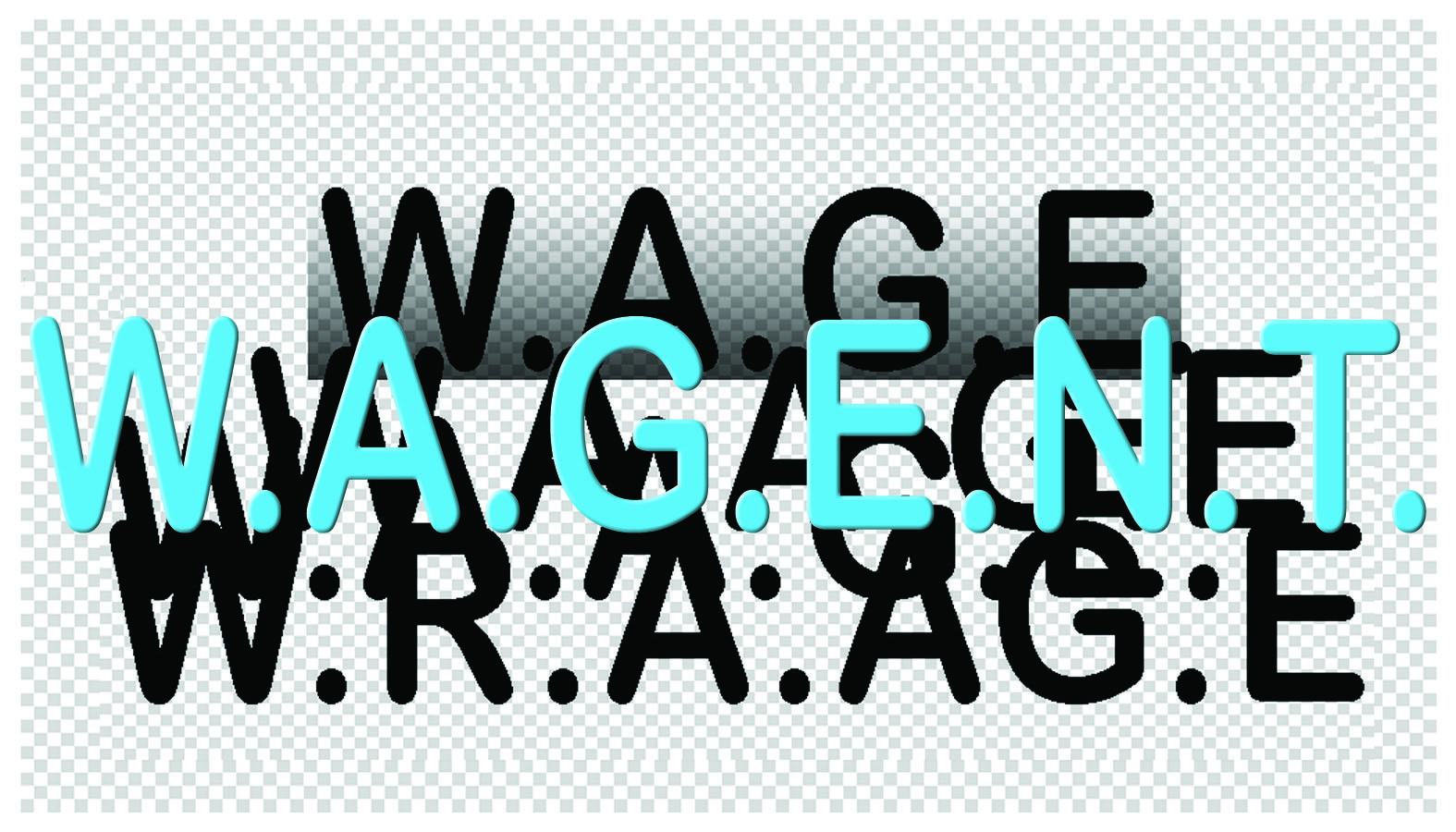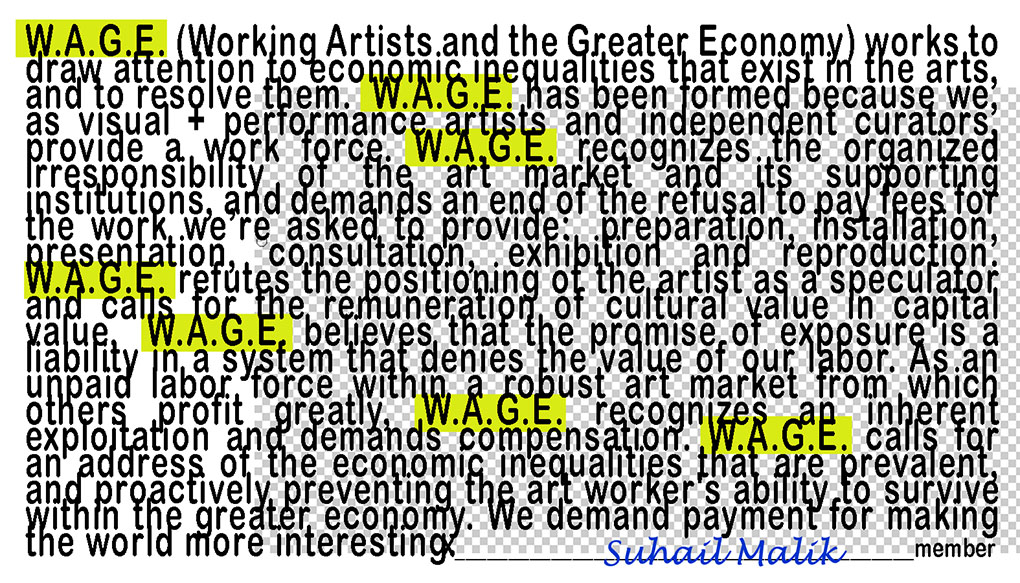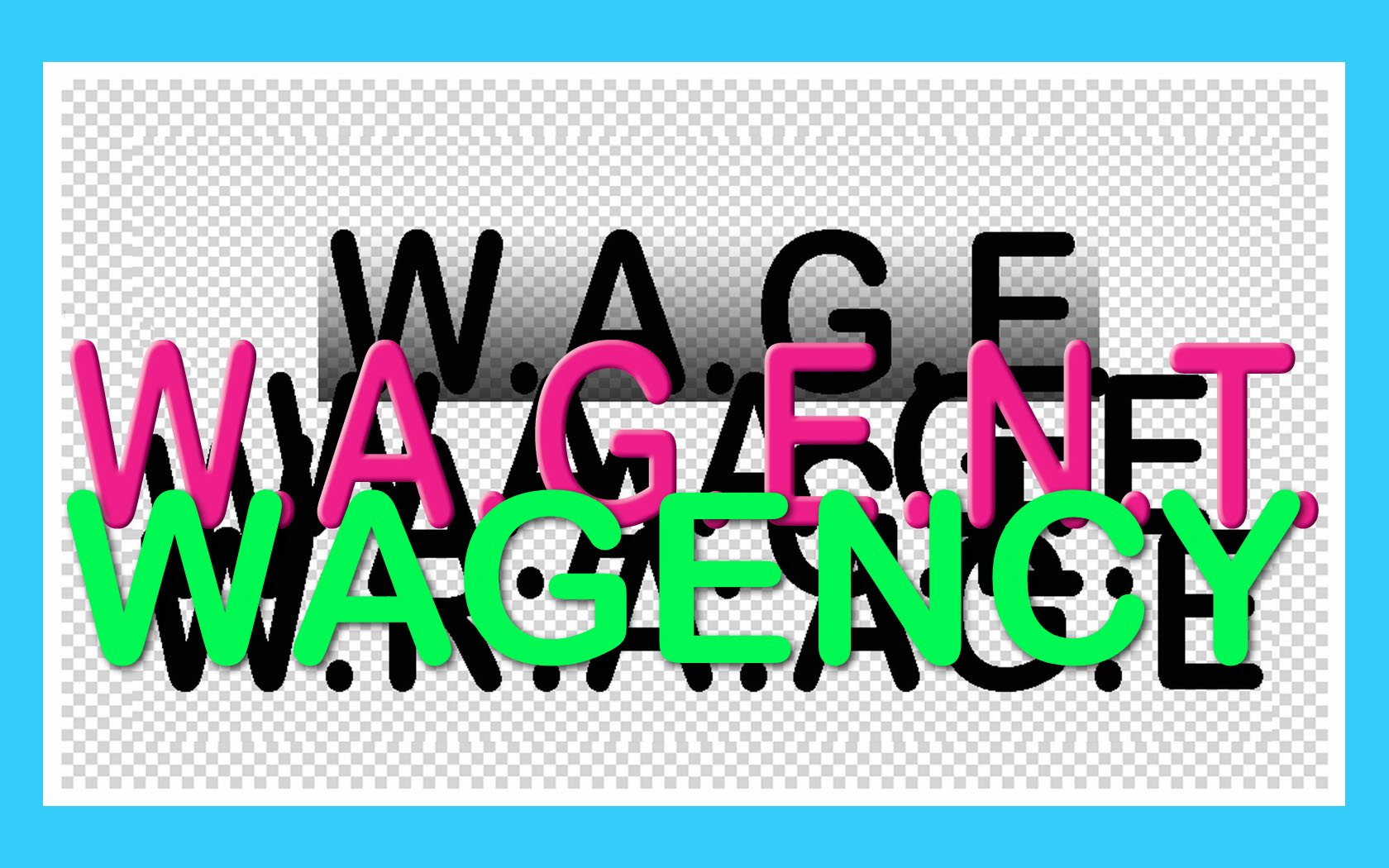WAGENCY Development Materials

WAGENCY was launched in 2018 but its development began in 2015 shortly after the introduction of W.A.G.E. Certification. Over the following 3 years it grew from its initial conception as an individual certification program into an artists' solidarity union and platform for negotiating, transacting, and withholding labor. In 2024, tools for calculating and negotiating equitable pay for occupations across the supply chain were added, along with labor divisions for art and cutural workers. The internal working documents cataloged on this page track the emergence of WAGENCY's 2018 policy framework.
INDIVIDUAL CERTIFICATION MINI-SUMMIT
In early November 2015, a mini-summit took place at MayDay Rooms in London, UK to establish the policy framework for 'Individual W.A.G.E. Certification', a parallel certification program for artists that had been conceived years before. The idea was to certify individual artists on the basis of their commitment to work only with institutions that pay fees according W.A.G.E. standards. Over two days, W.A.G.E. board members Suhail Malik, Marina Vishmidt, Tirdad Zolghadr, core organizer Lise Soskolne, and artist and writer Anthony Davies developed a set of guiding principles and the strategic approaches to effectively engage them. From these discussions "WAGENCY" emerged — a new form of labor organizing for an unpaid and atomized workforce. Below is the summit agenda in full.
W.A.G.E. Mini-Summit @ MDR: Individual Certification
November 1-2, 2015. With Anthony Davies, Suhail Malik, Lise Soskolne, Marina Vishmidt, and Tirdad Zolghadr.
DAY 1. Defining Political and Material Goals
i) To be or not to be a union?
The purpose of this session is to establish a political framework for Individual Certification (IC) by looking at its most basic functions as currently proposed: 1) A revenue stream for W.A.G.E. through the collection of fees for service; and 2) A mechanism for guaranteeing minimum standards for compensation in the nonprofit sector. Using the questions below, as well as the following sessions, we’ll necessarily come to a better understanding of how much or how little IC will be defined as or resemble a union formation.
What can or should this be beyond W.A.G.E. ‘brand licensing’?
What are we capable of providing now and/or what are we looking to provide in the long term?
Should what we establish now be sufficient in itself or can it function as a limited or foreshortened unionism, or 'seeds of unionization'?
Does unionization over-formalize more general and structural aims too soon?
Is IC an enforceable collective operation based on self-policing mechanisms within the sector without offering the 'services' and representational provision of unionization (such as forms of advocacy, access to pro bono legal advice etc)?
Should we try to build in the provision of financial support as well as more material social and political solidarity for those who may suffer by withholding their labor?
IC has inevitable international implications — do we build them in now or let them evolve?
Outcome: Decide generally what we’re capable of offering and what our political objectives are (much of this comes up again in subsequent sessions).
ii) A campaign against institutions or a campaign for the self-regulation of all?
As currently proposed, IC has the potential to hold institutions and artists/individuals equally accountable for perpetuating the conditions under which exploitation has become the norm. By placing the onus on artists to make demands, we’re also holding them accountable for their willingness to self-exploit through their claims to exceptionality. Positioning IC as being about artists and institutions taking responsibility is a logical extension of W.A.G.E.’s rhetorical and strategic position of late. However, IC can and already has been positioned as being a mechanism by which pressure is applied to as yet uncertified organizations to get certified a more adversarial us vs. them approach, like a union. Discuss pros and cons of each:
Campaign against institutions:
How can we not position the withholding of labor as a strategy to force as yet un-certified organizations to get certified since this is inherently a tactic to pressure them to follow W.A.G.E.’s guidelines?
Targeting institutions would align with traditional unionizing strategy and may be more effective in getting take-up from individuals.
Campaign for the self-regulation of all:
More likely to effect a systemic shift in behavior on both ends.
Signals collective responsibility out/up from individuals rather than only in support of them.
Strategically important to building strong alliances with institutions in order to draw attention to larger structural problems, namely the lack of state funding for art and more broadly the lack of social welfare.
W.A.G.E. doesn’t risk falling back into the artist as powerless victim trap, and in turn roll back or distort our gains thus far.
Outcome: Establish campaign strategy relative to institutions.
iii) Beyond artists’ labor?
Individual certification can — and should?! — extend beyond artistic or ‘creative’ labor to include art handlers, museum guards, and custodial staff, among others. There are two potentially beneficial outcomes to this approach: 1) Success in positioning artist’s labor as being no different to contract work in other fields like journalism; and 2) Success in equalizing or de-exceptionalizing the position of artists within institutions, and relative to their peers (as well as themselves) who both make art and work in institutions. While connected, the former represents a larger political aim that would align this campaign and W.A.G.E.’s work in general with other labor struggles, and the latter is specific to the art field.
Is it possible to certify an alliance or existing union?
Could we begin with certifying independent and in-house curators and if so, what would this involve?
Outcome: Define what “individual” is inclusive of in broad terms.
iv) A Fairness Model?
The purpose of this session is to determine how much IC’s guidelines should mirror Institutional Certification’s. Should artists be expected to commit to working only with organizations that provide fees according to W.A.G.E.’s current certification program or should we work toward something like a ‘fairness model’ that accounts for other forms of non-monetary exchange that could be of as much benefit to artists as fees in some cases? A fairness model might be something like ‘individual (non)-collective bargaining’ in that individuals would negotiate and set terms directly with institutions.
Is our goal to establish a formalized peer-to-peer structure with common criteria for the sector or are we looking to enforce specific and stricter compensation standards?
Would the most generative result be the establishment of common norms for everyone whether they are officially certified or not (as in Institutional Certification)?
How do we deal with not having access to the organization’s current operating budget and not being able to apply a current fee schedule: are minimums enough?
If we decide this extends beyond artists’ labor and that individuals must commit to only working with organizations that compensate according to W.A.G.E. standards, will we have to develop standards for every possible area of the field in order for this to work?
Outcome: Decide if we’ll use a ‘fairness’ model through which artists/individuals may negotiate their own terms, and which may include ‘compensation in-kind’ or if it should it be strictly about monetary compensation.
DAY 2. Establishing Mechanisms and Policy
i) How to protect and incentivize the participation of art’s ‘dark matter’?
More precariously positioned artists/individuals and those earning negligible revenues from their art — the overwhelming majority, or dark matter — lack the leverage to negotiate a fair deal. IC risks engendering bad faith with them, the very constituency we serve, by making it even more difficult to earn a living, get exposure or just present their work, causing further disempowerment. In other words, if someone already can’t afford to work for free, how could they possibly afford to withhold their labor? We don’t want to create a situation in which only those who can afford to turn down opportunities can be certified. The purpose of this session is to figure out how we can protect the dark matter while also tapping into their fundamental importance as a power base.
Possible solution: if we agree that this will require critical mass before it can begin to work, we start with signing on those already in a position to refuse opportunities to bear the initial burden. In this way the 1% would take the risk on behalf of the dark matter; also strategically advantageous since the big names will inspire others to sign on.
Possible solution: Create a ‘strike fund’ that could reimburse the amount that would have been received?
Outcome: Establish policy/strategy that protects those who can’t afford to withhold their labor while simultaneously encouraging them to participate.
ii) Parameters of individual as contractor
If individuals are to be held accountable for their own labor practices as employers as currently proposed, this session will set the parameters for what kind of subcontracted labor will be included. So far we know we want to ensure living wage standards for artist assistants and have discussed using a Living Wage Calculator as a minimum standard. However:
What other subcontracted workers should be included?
Is a living wage too low or can we stress that these are minimums as we do with Institutional Certification?
Can we propose minimum wage or a percentage of a job fee, whichever is greater?
What about the ‘Suzanne Lacy problem’: How do we account for social practice artists’ incorporation of large numbers of participants/constituencies in their work? Do they qualify as assistants or as ‘subcontracted artists’ as defined by Institutional Certification, and thus should the artist be paying them or the institution (we need to figure this out for the current program anyway)?
Outcome: Establish list/limit of those who would be subject to minimum payment standards by individuals as subcontractors.
iii) Parameters of auditing and policing
If individuals publicly avow to uphold certain responsibilities by being listed as ‘W.A.G.E. Certified’ on our website, the purpose of this session is to establish the parameters and mechanisms for auditing and policing them on those terms.
Do we create a forum or mechanism for those who want to lodge complaints against individuals they believe are not in compliance?
Do we quietly remove a non-compliant individual’s name (soft policing) or use a shaming tactic?
Outcome: Establish parameters for the auditing and policing the fair practices of individuals as subcontractors.


WAGENCY FOCUS GROUP
After the framework for WAGENCY was established in November 2015, a working policy was drafted over the following months. In May 2016, W.A.G.E. organized a focus group of roughly 25 people to give feedback on the document and contribute to WAGENCY's development. Below is the handout summarizing the policy to date as well as an agenda for the discussion.
W.A.G.E.N.C.Y. Artist Certification & Coalition Focus Group
May 11, 2016 at Artists Space Books & Talks.
Core Principles and Logistical Information
Purpose
1.
To build political and economic solidarity between artists.
2.
To provide broad agency to artists of varying means.
3.
To enlist artists in sharing responsibility with institutions for the process of shifting the entire field toward something more sustainable.
Scope & Oversight
The payment of artist fees by the nonprofits that contract artists to provide content for their programs.
The payment of artist assistants who contribute to the production of content on a subcontracted basis.
"Artists" are those who supply content in a nonprofit visual arts presenting context, including visual artists, performers, dancers, poets, filmmakers, writers, and musicians among others.
Artist fees are not intended as compensation for the labor or materials of making art but are the expected remuneration for an artist’s temporary transactional relationship with an institution to provide content. Payment is not for the content itself but is for its provision.
Shared Principles of Equity
1.
Solidarity between artists and their collective engagement in the work of shifting the entire field toward something more sustainable.
2.
Access to resources and tools that make the political engagement of artistic labor possible.
3.
The continuation of W.A.G.E.
Levels of Engagement
Certified Artists
Withhold content when not paid fees according to W.A.G.E. standards.
Pay equitably those subcontractors who contribute directly to producing the content of their work.
Publicly listed on wageforwork.com as W.A.G.E. Certified;
Gain access to an online platform for information-sharing and tools that support effective negotiation and/or the withholding of content when necessary;
Assigned a number and receive a digital signature;
Pay an annual fee of TBD.
W.A.G.E. Coalition
Publicly listed;
Have access to online tools and resources;
Assigned a number and digital signature to be used in correspondence with institutions to indicate that they are part of a broader network advocating for equity within the sector;
Pay an annual fee of TBD;
Have the ability to become a Certified Artist at any time with no cost increase.
Discussion Agenda
The question of class division
1.
Are we reinforcing/condoning class division by enabling — and insisting — that artists engage their work through existing ‘class positions’ (“Blue chip vs. No-chip”)?
2.
Would we more effectively build solidarity by leveling class division through insisting on a single and uniform mode of participation? This could take the form of collective W.A.G.E.N.C.Y: a broad membership base along with voluntary self-regulation by those who can: a kind of ‘fairness model’ that enables artists to individually negotiate the terms of their engagement. This also leaves open the option of working for free sometimes, when appropriate, or for other forms of non-monetary compensation.
3.
Is it unionization in name only to allow artists to join the coalition and ask nothing of them in terms of risk? Does calling it ‘participation’ instead of ‘membership’ change anything? Alternative is that an artist can only be certified and a member, or else they are simply a ‘W.A.G.E. Fan’ or ‘W.A.G.E. Supporter’.
4.
By asking participants of varying means to pay the same annual flat fee, are we trying to dissolve class stratification in precisely the wrong way — in other words, should those who make more be expected to pay more? The fee to join could be determined according to annual income but this presents real administrative problems for us as an organization. Another possibility: artists who earn under a minimum overall per year get a reduced rate.
Artist assistants and the remuneration of content production
This discussion pivots around the question of class division, since only those artists who earn enough money can afford to employ assistants, and these artists are likely to enjoy enough demand for their work to require them. It also speaks to the dual class position of artists: operating as contracted workers relative to institutions, and as contractors relative to the labor of their assistants.
Artist assistants perform a combination of intellectual, affective, highly skilled and unskilled labor, enabling artists to multiply their output and increase profits by a significant margin. Not only do assistants not share in these profits, they are contracted on terms that significantly increase their existing precarity: as subcontractors they have no claim to job security or benefits and their employment is tied directly to the mercurial success of their employers on the commercial market.
There is much to discuss on this subject but the central issue is how the relationship between artists and their assistants reproduces the very conditions of exploitation we’re working against, and what we can do about it. This is an open discussion about the nature of collaboration and what is fair in terms of compensation.
